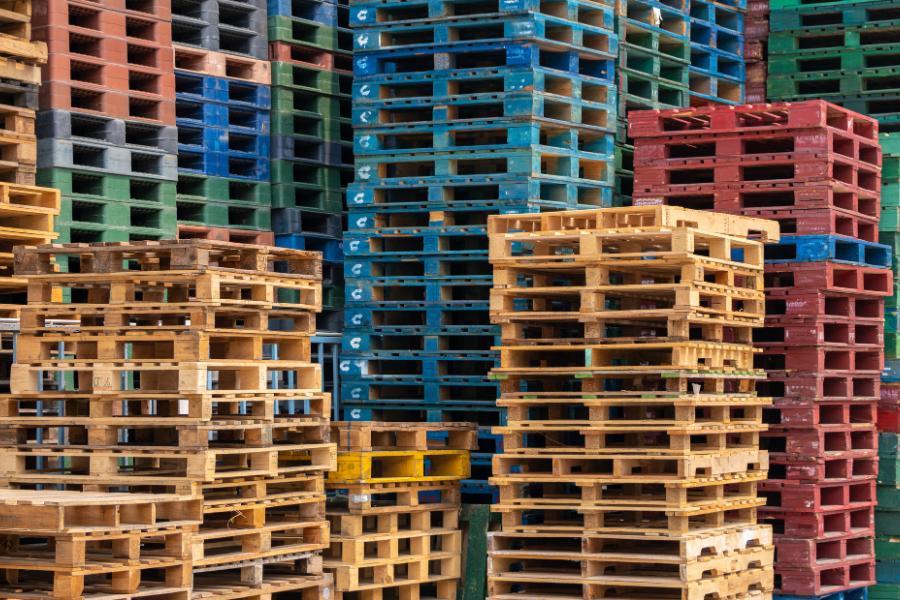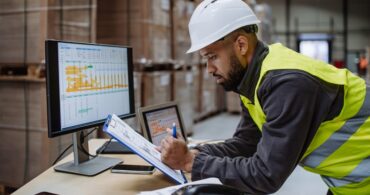The average person probably does not spend much of their day thinking about the humble pallet. However, as anyone in the logistics industry knows, different pallet types are anything but humble.
The many different types of pallets are used for diverse industries and are constructed of various materials. In addition, some industries have unique needs that require unique pallets, and these pallet types can vary widely in size and shape.
What is a pallet?
A pallet is a flat structure used as a base for storing, handling and transporting goods and materials within warehouses and distribution centers. Pallets are a stable platform for goods to be stacked and moved by forklifts, pallet jacks and other material handling equipment.
During World War II, the U.S. Department of Defense established a standardized 1200-x-1000-millimeter, four-way-entry pallet that works with all forklifts in the U.S. and Japan known as the ISO or universal pallet. However, it’s not actually “universal” because the standard size of a pallet is 1200 x 800 millimeters in Europe. Additionally, some industries have unique needs that require pallets of other dimensions.
Pallet materials
There are four general materials used to construct pallets, each providing different advantages.
Wood
Wooden pallet types are the most widely used. Wooden pallets are affordable, easy to repair and recyclable. However, they can be prone to damage and have weight variations based on the type of wood used.
There are many types of wood pallets, but they all fall under two categories: hardwood or softwood. Examples of hardwoods include oak, maple and mahogany. Hardwood pallets are stronger than those made from softwood, but they tend to be more expensive because the wood takes longer to grow and may grow in areas that are less easily managed.
Examples of softwoods include Douglas fir, pine and spruce. Pine is frequently used because it grows in diverse environmental areas and is easy to process.
Plastic
Plastic pallets are more expensive than wooden ones, but they can be used much longer than wooden pallets. Because plastic pallets are durable, sanitary and resistant to moisture and chemicals, they are typically utilized by the food, pharmaceutical and other industries with strict hygienic requirements. However, most plastic pallets have a weight limit and should not be used to carry loads heavier than 1,500 pounds.
Metal
Metal pallets are stronger and more durable than both their wood and plastic counterparts. While they also cost considerably more (on average $50-$200 per pallet), they have a typical lifespan of ten years. Metal pallets are usually used in industries with heavy-duty applications, such as manufacturing and automotive.
Corrugated paper
Paper pallets are surprisingly strong and can handle most of the same cargo as a wooden pallet. They are also inexpensive, lightweight and environmentally friendly. However, paper pallets have an extremely limited lifespan and are often intended for a single use. For this reason, paper pallets are primarily used for one-way shipping applications.
Types of pallets in warehouse applications
There are generally seven different pallet styles.
Block pallets
Block pallets are the standard four-way-entry pallets similar to those developed by the Department of Defense decades ago. Block pallets are supported by several blocks of wood (or plastic, etc.) placed at the corners and the center of each side. Block pallets are known as four-way pallets because forklifts can access them from any side.
Stringer pallets
Stringer pallets are like block pallets, except they are supported by solid boards that run along the left and right sides of the pallet (known as stringers). Due to these solid boards, forklifts can only enter most stringer pallets from the front or the back, although some solve this issue by cutting notches into the solid boards.
Double-face pallets
Double-face pallets have deck boards (the horizontal planks that create a pallet’s flat surface) on the top and bottom of the pallet. In addition to providing a four-way entry, this design makes the pallets reversible.
Double-wing pallets
Double-wing pallets have deck boards that extend past the blocks (or stringer boards) creating a larger surface area. These pallets are commonly used in industries with unevenly shaped load requirements.
Solid deck pallets
Instead of deck board slats, a solid deck pallet uses a sheet of plywood (or other material) for the top surface (some pallets are reversible with a solid base, as well). Solid deck pallets are useful for carrying small items that may fall through deck board cracks or items that may move on slats and spill. Also, if a spill occurs, solid deck pallets are easy to clean.
Roto-molded pallets
These plastic pallets are made using a rotational molding method. During roto-molding, resins are added into a mold that’s heated and slowly rotated both vertically and horizontally. It’s a cost-effective method that creates large, hollow plastic pieces. Some roto-molded pallets include a steel frame to increase their load-bearing capacity.
Injection-molded pallets
Injection molding is a manufacturing process where molten plastic is injected into a mold cavity and then cooled to solidify. Injection-molded pallets are solid plastic, so they tend to be stronger than roto-molded pallets. They are also washable and recyclable.
Now that the nagging “what are pallets?” question is solved, it’s time to turn to the machines that move those pallets throughout storage facilities and worksites. Are your electric forklifts and other material-handling equipment operating at their highest efficiency? Texas Motive Solutions can answer that question with their complimentary forklift fleet performance analysis. We also have the forklift batteries and accessories you need to keep your fleet up and running. Give us a call at (888) 316-2459 or fill out this form to learn about our services and discover everything we can do for you.



